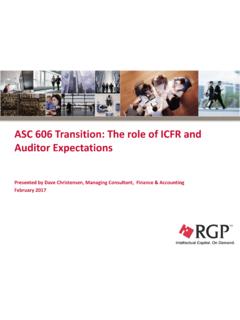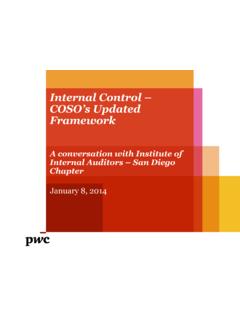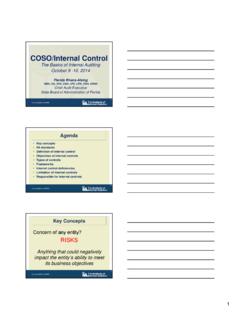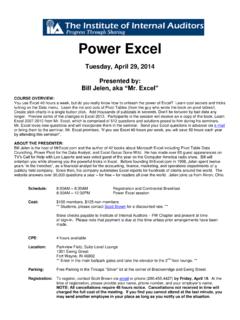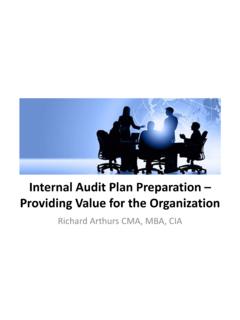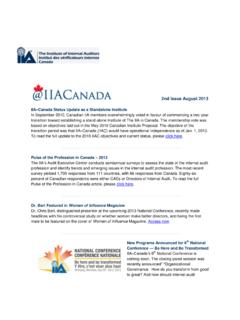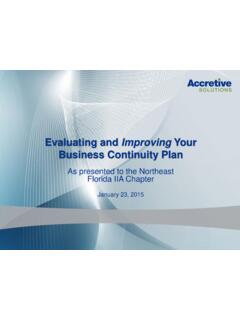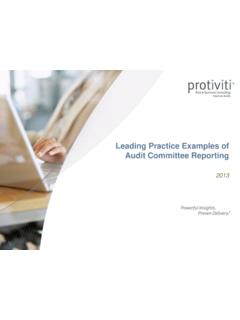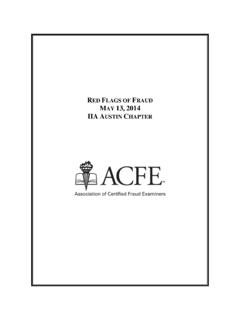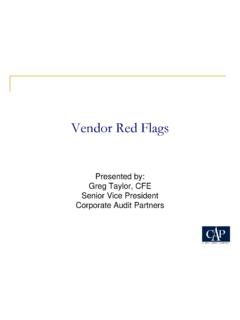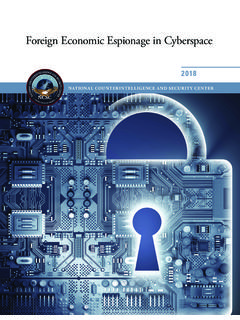Transcription of Developing the IT Audit Plan
1 Developing the IT Audit PlanGlobal Technology Audit Guide (GTAG)Written in straightforward business language to address a timely issue related to IT management, control, and security, the GTAG series serves as a ready resource for chief Audit executives on different technology-associated risks and recommended practices. Information Technology Controls: Topics discussed include IT control concepts, the importance of IT controls, the organizational roles and responsibilities for ensuring effective IT controls, and risk analysis and monitoring and PatchManagement Controls: Critical forOrganizationalSuccessChange and Patch Management Controls: Describes sources of change and their likely impact on business objectives, as well as how change and patch management controls help manage IT risks and costs and what works and doesn t work in Auditing: Implications for Assurance,Monitoring, and Risk AssessmentContinuous Auditing: Addresses the role of continuous auditing in today s internal Audit environment; the relationship of continuous auditing, continuous monitoring, and continuous assurance.
2 And the application and implementation of continuous of IT AuditingManagement of IT Auditing: Discusses IT-related risks and defines the IT Audit universe, as well as how to execute and manage the IT Audit AuditingPrivacy RisksManaging and Auditing Privacy Risks: Discusses global privacy principles and frameworks, privacy risk models and controls, the role of internal auditors, top 10 privacy questions to ask during the course of the Audit , and and AuditingIT VulnerabilitiesManaging and Auditing IT vulnerabilities : Among other topics, discusses the vulnerability management life cycle, the scope of a vulnerability management Audit , and metrics to measure vulnerability management practices.)NFORMATION 4 ECHNOLOGY /UTSOURCINGI nformation Technology Outsourcing: Discusses how to choose the right IT outsourcing vendor and key outsourcing control considerations from the client s and service provider s operation. AuditingApplication ControlsAuditing Application Controls: Addresses the concept of application control and its relationship with general controls, as well as how to scope a risk-based application control review.
3 Identity and Access ManagementIdentity and Access Management: Covers key concepts surrounding identity and access management (IAM), risks associated with IAM process, detailed guidance on how to Audit IAM processes, and a sample checklist for Continuity ManagementBusiness Continuity Management: Defines business continuity management (BCM), discusses business risk, and includes a detailed discussion of BCM program requirements. Visit The IIA s Web site at to download the entire Rehage, Chevron CorporationSteve Hunt, Crowe Chizek and Company LLCF ernando Nikitin, Inter-American Development BankDeveloping the IT Audit PlanJuly 2008 Copyright 2008 by The Institute of Internal Auditors, 247 Maitland Avenue, Altamonte Springs, Fla., 32701-4201. All rights reserved. Printed in the United States of America. No part of this publication may be reproduced, stored in a retrieval system, or transmitted in any form by any means electronic, mechanical, photocopying, recording, or otherwise without prior written permission from the IIA publishes this document for informational and educational purposes.
4 This document is intended to provide information, but is not a substitute for legal or accounting advice. The IIA does not provide such advice and makes no warranty as to any legal or accounting results through its publication of this docu-ment. When legal or accounting issues arise, professional assistance should be sought and Table of ContentsTable of Contents1. ExEcutivE SummAry ..12. introduction .. IT Audit Plan Development Process ..33. undErStAnding thE BuSinESS .. Organizational Uniqueness .. Operating Environment .. IT Environment Factors ..44. dEfining thE it Audit univErSE .. Examining the Business Model .. Role of Supporting Technologies .. Annual Business Plans .. Centralized and Decentralized IT Functions .. IT Support Processes .. Regulatory Compliance .. Define Audit Subject Areas .. Business Applications .. Assessing Risk ..115. PErforming A riSk ASSESSmEnt .. Risk Assessment Process .. Identify and Understand Business Objectives.
5 Identify and Understand IT Strategy .. IT Universe .. Ranking Risk .. Leading IT Governance Frameworks ..146. formAlizing thE it Audit PlAn .. Audit Plan Context .. Stakeholder Requests .. Audit Frequency .. Audit Plan Principles .. The IT Audit Plan Content .. Integration of the IT Audit Plan .. Validating the Audit Plan .. The Dynamic Nature of the IT Audit Plan .. Communicating, Gaining Executive Support, and Obtaining Plan Approval ..217. APPE ndix: hyPothEticAl comPAny ExAmPlE .. The Company .. The IT Audit Plan ..228. gloSSAry of tErmS ..279. gloSSAry of AcronymS ..2810. ABout thE AuthorS ..291 GTAG Executive Summaryand low-risk areas through quantitative and qualitative analyses. IT is in a perpetual state of innovation and change. Unfortunately, IT changes may hinder the IT auditor s efforts to identify and understand the impact of risks. To help IT auditors, CAEs can:Perform independent IT risk assessments every year to identify the new technologies that are impacting the organization.
6 Become familiar with the IT department s yearly short-term plans and analyze how plan initiatives impact the IT risk each IT Audit by reviewing its risk assessment flexible with the IT Audit universe monitor the organization s IT-related risk profile and adopt Audit procedures as it IT governance frameworks exist that can help CAEs and internal Audit teams develop the most appro-priate risk assessment approach for their organization. These frameworks can help auditors identify where risks reside in the environment and provide guidance on how to manage risks. Some of the most common IT governance frameworks include COBIT, the UK s Office of Government Commerce IT Infrastructure Library (ITIL), and the International Organization for Standardization s (ISO s) 27000 Standard series. Mapping business processes, inventorying and under-standing the IT environment, and performing a companywide risk assessment will enable CAEs and internal auditors to determine what needs to be audited and how often.
7 This GTAG provides information that can help CAEs and internal Audit teams identify Audit areas in the IT environ-ment that are part of the IT Audit universe. Due to the high degree of organizational reliance on IT, it is crucial that CAEs and internal auditors understand how to create the IT Audit plan, the frequency of audits, and the breadth and depth of each Audit . To this end, this GTAG can help CAEs and internal auditors:Understand the organization and the level of IT support 1. and understand the IT Identify the role of risk assessment in determining the IT 3. Audit the annual IT Audit Finally, this GTAG provides an example of a hypothetical organization to show CAEs and internal auditors how to execute the steps necessary to define the IT Audit universe. 3 GTAG: Management of IT Auditing, pp. 6 and Summary1. As technology becomes more integral to the organization s operations and activities, a major challenge for internal audi-tors is how to best approach a companywide assessment of IT risks and controls within the scope of their overall assurance and consulting services.
8 Therefore, auditors need to under-stand the organization s IT environment; the applications and computer operations that are part of the IT infrastructure; how IT applications and operations are managed; and how IT applications and operations link back to the organization. Completing an inventory of IT infrastructure compo-nents will provide auditors with information regarding the infrastructure s vulnerabilities . The complete inventory of the organization s IT hardware, software, network , and data components forms the foundation for assessing the vulnera- bilities within the IT infrastructures that may impact internal controls. 1 For example, business systems and networks connected to the Internet are exposed to threats that do not exist for self-contained systems and Once an adequate understanding of the IT environment has been achieved, the chief Audit executive (CAE) and the internal Audit team can perform the risk assessment and develop the Audit plan.
9 Many organizational factors are considered when devel-oping the Audit plan, such as the organization s industry sector, revenue size, type, complexity of business processes, and geographic locations of operations. Two factors having a direct impact on the risk assessment and in determining what is audited within the IT environment are its compo-nents and role. For example:What technologies are used to perform daily busi- ness functions? Is the IT environment relatively simple or complex? Is the IT environment centralized or decentralized? To what degree are business applications customized?Are some or all IT maintenance activities outsourced?To what degree does the IT environment change every year? These IT factors are some of the components CAEs and internal auditors need to understand to adequately assess risks relative to the organization and the creation of the annual Audit plan.
10 In addition to factors impacting the risk assessment, it is important for CAEs and internal auditors to use an approach that ascertains the impact and likelihood of risk occurrence; links back to the business; and defines the high-, medium-, 1 GTAG: Information Technology Controls, p. GTAG: Information Technology Controls, p. Introductionmanagement has heightened expectations regarding IT delivery functions: Management requires increased quality, functionality and ease of use; decreased delivery time; and continuously improving service levels while demanding that this be accomplished at lower costs. 4 Regardless of the methodology or frequency of Audit planning activities, the CAE and the internal Audit team should first gain an understanding of the organization s IT environment before performing the Audit . The use of tech-nology is an essential part of an organization s activities.
